Aster novi-belgii 'Tonga'
MICHAELMAS DAISY, NEW YORK ASTER
Family: Asteraceae
Pronounced: As-ter NO-vee-BEL-gee-ee
Quick Jumps
Growing Guide
Rainy Side Notes
GROWING GUIDE

Geographic origin:
Garden origin.
Plant group:
Perennial.
Hardiness:
Sunset zones: All (Western).
USDA zones: 4-8.
Mature size:
Height: 24 inches (60 cm).
Width: 24 inches (60 cm).
Flowering period:
Early September until first frost.
Flowering attributes:
Purple flowers with orange centers.
Leaf attributes:
Dark green lanceolate leaves.
Growth habit:
Clump forming.
Light:
Full sun.
Soil:
Moist, moderately fertile, well drained soil.
Feeding:
A mulch of compost or manures applied in fall. Apply a complete organic fertilizer in spring. After cutting back growth in early summer, a light fertilizing with fish fertilizer will help with new leaf growth.
Propagation methods:
Division in early spring or late fall. | Root basal cuttings in spring.
Pruning methods:
You can prune back in early summer for bushier growth, but A. 'Tonga' has a compact and bushy growth so there is no need for pruning as with some of the other asters.
Rainy Side Notes
For autumn, asters cannot be beat for wonderful fall colors. Just when you think summer is over and your garden is going to fade, out pops the beautiful asters asking, no, insisting you pay attention. The purple of this Aster 'Tonga' blends and compliments the many jewel tone colors of autumn. I planted three plants but believe five or seven planted in a drift would be better. Planted at the base of tall Solidago canandensis would be an eye-popping, brilliant pairing as they both are in full bloom at the same time.
New York asters last as a cut flower for 8-12 days when properly harvested. Cut the stems when 1/4 of the flower has opened and place it immediately into water.
These asters last as a cut flower for 8-12 days when properly harvested. Cut the stems when ¼ of the flower has opened and place it immediately into water.
Article: Planning a Colorful Autumn Garden.
Photographed in author's garden.

Gardening for the Homebrewer: Grow and Process Plants for Making Beer, Wine, Gruit, Cider, Perry, and More
By co-authors Debbie Teashon (Rainy Side Gardeners) and Wendy Tweton
Copyright Notice | Home | Search | Perennials

